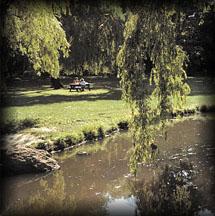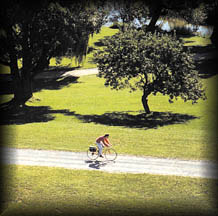

Parks managers face difficult challenges when making fertilizer management decisions. Economic restrictions tend to steer purchases to the least expensive option, when looking at fertilization, as well as other management tools. As we all know however, the slogan, "you get what you pay for" or "quality doesn't cost, it pays", rings true in this situation. The cheapest fertilizer products are generally the least desirable, from an environmental standpoint...high leach ability, high burn potential, high toxicity to soil, micro flora and fauna etc.
The majority of fertilizer, which is used in the municipal market, is supplied through a "tendering" process, where the cheapest bid is awarded the contract. Despite specifications being tightly written by the parks manager, cheaper products (per bag) are often chosen by purchasing departments. Although this system was designed to ensure a fair purchase price, the result is that parks managers rarely receive the products which are best suited for their needs.
Concern for the environment is of increasing importance by the public. Public perception of spraying has changed the way in which many turf managers attack the problem of weeds, insects or other pests. The most common approach to handling this problem is by using granular applications of pesticides. From an environmental standpoint, granular applications often require more pesticides per unit area to treat the problem...also...is the timing correct for some of these combination products? This is not to say that granular applications of combination products (ie. weed and feed) do not have a place in turf management. It is to indicate that management decisions are being driven by public perception, rather than being the best decision made by the turf grass manager.

Over the past ten years I have been working with parks managers in an attempt to assist in designing a fertilization program which suits the economic and environmental concerns surrounding parks management. Many park managers have wanted to explore the possibilities of "organic" fertilizers. The public would be extremely proud to state that no pesticides and only organic fertilizers are used in their district. It has been my experience however that the cost of organic fertilizers makes this prohibitive (Organic fertilizers defined as natural organic derived from natural sources such as protein meals... bone meal, blood meal, feather meal or composted products such as poultry manure. Although organic is strictly defined as "containing carbon" urea based fertilizers are not classified as natural organic). From a cost standpoint, to provide the same units of NPK with organic (as defined above), will cost approximately 6 times as much.
Naturalization of 'passive' parks is an excellent way to both, reduce management costs and provide an environment for a more diverse group of plant and animal species. The initial development of natural areas is a challenge, since it is more than just stopping mowing. This simply results in an aesthetically displeasing assortment of undesirable weeds. Input costs will be initially high to develop these areas, but the long term costs should be greatly reduced. The first step to finding a "middle" ground" should be to decide which park areas can be developed into natural areas. This will allow for a reduced area requiring the higher maintenance of fertilization, mowing and weed control....all requirements for a quality turfgrass stand.
The remaining park areas can be subdivided again into 2 or 3 different levels of maintenance. The highest level of maintenance will be required for sports turf surfaces. To achieve a quality playing surface which is safe and effective, takes a great deal of effort. The World Cup Soccer Championship showed us a prime example of sports turf at its best. Every district would like to be able to provide these type's of fields for the community. Fertilization levels for sports fields depends upon the soil type, age, irrigation frequency, etc., but will range from 3lb nitrogen per 1000sq. ft. to 6lb nitrogen per 1000sq ft. Potassium is an important element in sports fields, due to the wear tolerance and disease resistance it promotes. Phosphorous is an important element also, due to its value in root promotion, where there is a need for constant overseeding of wear areas. In my experience, organic fertilizers do not provide the nutrients at the rate desirable for the re-generation of top-growth on sports turf. They can however, assist in adding a food source for micro organisms on high sand content rootzones...which are notorious for low microbial content. Another desirable attribute for a sports field fertilizer would be consistent growth response. Growth surges after fertilization, or rain can cause safety concern for the playing surface...slow play, poor foot traction, as well as difficulty for the turf manager to keep up with the mowing.

The next highest maintenance level would be those areas classified as highly visible or formal. In these areas a balanced fertilizer program providing 3lb nitrogen, 5lb phosphorous and 1.5lb potassium (per 1000sq ft) is ideal. Again, the value of consistent growth, low leach ability and low burn potential, pay dividends when it comes to ease of maintenance, visual appeal, and low environmental impact.
Park areas which are not "naturalized" but are also lower profile, probably make up the majority of acreage. In these areas, traditionally a low cost fertilizer, with high levels of readily available nitrogen, have been used. I often hear, "we can't afford to use a higher grade fertilizer in these areas"... "but when I fertilize, I can't keep up with the mowing"! Nitrogen promotes shoot growth. The more available nitrogen you apply....the more shoot growth will result. Nitrogen is an extremely mobile element. When it is applied in an available form (not controlled release) it will either be converted to ammonia gas and be lost into the air (can be 45% loss) be converted to nitrate and be leached through the soil (can be 35-40% loss) be converted to Ammonium and be absorbed by the soil or be taken up by the roots in the form of nitrate, usually, or ammonium... if taken up in excess quantities, this is called luxury consumption, generally what we know as surge growth.
IBDU (isobutylidene diurea) is a controlled release nitrogen source, which is ideal for trufgrass management. Although, it is a higher cost per unit of nitrogen, it controls the release of the nitrogen so that consistent turfgrass response, is the result in all types of weather conditions. From an environmental standpoint it is, by nature, low leaching, has a lower salt index than natural organic, consequently has a low toxicity to soil microflora / fauna and won't burn the turf. From an economic standpoint, fewer applications are required, the consistency of release and turfgrass growth make the overall management picture easier and more economical. A quality IBDU product assits both economically and environmentally, perfectly suited for medium maintenance, high acreage areas. IBDU products provide consistent controlled release nitrogen over 5 months and 20% sulphur coated urea, providing slow release nitrogen over 6-8 weeks.
Composting of leaves, grass clippings and other organic material is an excellent way for a municipality to Reduce, Reuse and Recycle. As an organic soil amendment, it can add a tremendous amount of nutrition, microorganisms and nutrient holding capacity to the soil. Developing a composting program and using the material in the parks (flower beds, top-dressing of sports fields for example) can only assist in the overall health of the environment and reduce the dependency on fertilizer inputs.
Considering the issues that surround parks maintenance; specifically the economic and environmental concerns, there are a number of tactics which can be used to make better use of fertilizer dollars.
1) Select a portion of the parks acreage which can be developed into natural areas. After established, these areas will become self-sustaining and require little or no fertilization
2) Steer more of the maintenance dollars towards the development of quality sports turf surfaces.
3) Select a fertilizer which spreads the availability of the nutrients over a longer period of time to reduce environmental impact and labor costs.
4) Focus on educating the parks managers on proper fertilizer techniques, composting, and all areas of turf grass management. An educated manager will make the best buying decisions.
5) Develop a composting program
Economic considerations have traditionally been winning out over environmental issues, when it comes to fertilizer purchases in public parks. Total "organic" approaches, driven by public perception, are not the best solution from an agronomic and economic standpoint. A middle ground can be found by targeting high and low maintenance areas, developing natural areas, composting organic material and using higher grade controlled release fertilizers. The overall maintenance picture must incorporate long and short term benefits, considering the effects on all aspects of parks maintenance.
DAISY MOORE B.Sc.. Agr. (P Ag) Daisy is a horticulturist
at Vigoro Canada Inc. Along with her extensive experience in the
fertilizer industry, she is an avid gardener and naturalist.